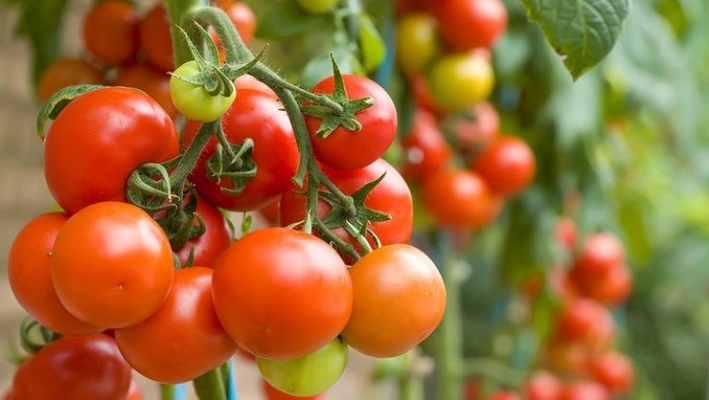Solan Bajr (U.H.F II): It is a new variety. It has heart shaped, hard and thick peel fruit. The fruit has approximately 70gm weight. The variety gets ready in 70-75 days and gives an average yield of 177-197qtl/acre. It is approved for intermediate hilly areas.
Solan Gola: High spreading variety, round fruits, medium to big size, thick peel, and have good transportation quality. It gives an average yield of 156qtl/acre.
Yashwant (A-2): High spreading variety, round fruits, flat and thick peel, resistant to fruit rot. It gives an average yield of 208qtl/acre.
Marglobe: High spreading variety, round fruits, bigger in shape, thick peel and outer skin of unripe fruit is green, resistant to fruit rot. It gives an average yield of 166qtl/acre.
Syu: High spreading variety, medium size fruits, almost round, unripe fruit is light green in color but red when matures. . It gives an average yield of 145qtl/acre.
Solan Shagun: Medium height hybrid variety, deep green color leaves, deep red color fruits, variety gets ready in 70-75 days. It gives an average yield of 145qtl/acre. The variety is resistant to wilt and fruit rot disease.
Roma: Dwarf variety, more leaves, pear shaped fruits, thick peel and good transportation quality. The variety is suitable for growing in Kullu hills. It gives an average yield of 130qtl/acre.
Rupali: Medium spreading hybrid variety, round shape fruits, medium size and good transportation quality. It gives an average yield of 208qtl/acre.
M.T.H -15: Medium spreading, hybrid variety, round and thick peel fruits. It gives an average yield of 188qtl/acre.
Naveen: Medium spreading, hybrid variety, round fruits and good transportation quality. It is approved for growing in Solan and other adjoining areas. It gives an average yield of 167-188qtl/acre.
Palam Pink (B.L. 342-I): It is a new variety which is resistant to bacterial wilt disease. The variety is approved for low and intermediate hilly areas. It is a dwarf plant, pink color fruits and gives an average yield of 100qtl/acre.
Palam Pride: It gives an average yield of 98qtl/acre.
Solan Garima: Hybrid variety, 3-4 fruits per bunch, variety get ready in 80-85 days, fruits are having an average weight of 85gm, round fruit, deep red color and thick peel fruits, long time transportation quality, give an average yield of 275qtl/acre. The variety is suitable for sowing in summer season in intermediate hilly areas.
Solan Sindhoor: Hybrid variety 3-4 fruits per bunch, variety get ready in 75-80 days, fruits are having an average weight of 60gm, round fruit, deep pink color and thick peel fruits, T.S.S is 4.5 brix, good transportation quality, give an average yield of 270qtl/acre. The variety is suitable for sowing in summer season in intermediate hilly areas.
Him Pragti: Suitable for high dried temperate areas (Lahaul hills). Fruits are deep red, medium pear shaped, in bunches, thick peel, resistant to cold. The variety gets ready in 85 days and gives 46% more average yield than Roma variety.
Other state varieties:
Pusa Rubi: Variety developed by IARI, New Delhi. Suitable for spring as well as winter season cultivation. Gives average yield of 133qtl/acre.
Pusa Early Dwarf: Variety developed by IARI, New Delhi. Fruits are medium dwarf, with yellow stem. Ready to harvest 75-80 days after transplantation. Gives average yield of 140qtl/acre.
Punjab Chhuhara: Fruits are seedless, pear shape, red, firm with thick wall or skin. Marketable quality remains for 7 days after harvesting and thus suitable for long distance transportation and processing.
Pusa 120: Variety developed by IARI, New Delhi. Fruits are medium dwarf, smooth, attractive with yellow stem. It is resistant to nematodes.
Roma Selection 120: Developed by IARI, New Delhi. It gives resistant to root knot nematodes.
Pant Bahar: Fruits are round with medium size.
Arka Vikas: Variety released by IIHR, Bangalore. Crop ready to harvest in 120 days. Gives average yield of 140-160qtl/acre.
Hisar Aruna : Developed by Hissar, HAU. Early and high yielding variety. Fruits are medium-large, round, deep red color.
Karnataka Hybrid: Crop is ready to harvest 80 days after transplantation. Fruits are long and oval shape. It is resistance to wilt and nematodes.
Rashmi: Widely adopted hybrid. Fruits are medium, round with attractive color. It is resistant to wilt disease.
HS 101: Suitable for growing in North India during winter condition. Plants are dwarf. Fruits are round and medium size and juicy. Fruits are borne in cluster. It is resistant to Tomato Leaf Curl Virus.
HS 102: Early maturing variety. Fruits are small to medium in size, round and juicy.
Sonali: Gives average yield of 300-320 qtl/acre.
Pusa Hybrid 1: Developed by ICAR, New Delhi. Gives average yield of 128 qtl/acre.
Pusa Hybrid 2: Developed by ICAR, New Delhi. Fruits are flat, round with thick skin. Gives average yield of 220qtl/acre.
ARTH-3: Ready to harvest in 80-85 days after transplantation. Gives average yield of 350-380qtl/acre.
Keekruth: Plant height is about 100cm. Ready to harvest in 136 days. Fruits are medium to large size, round shape, deep red color.
Keekruth Ageti: Plant height is about 100cm. Fruits are medium to large size, round shape having green shoulder which disappears on ripening.











